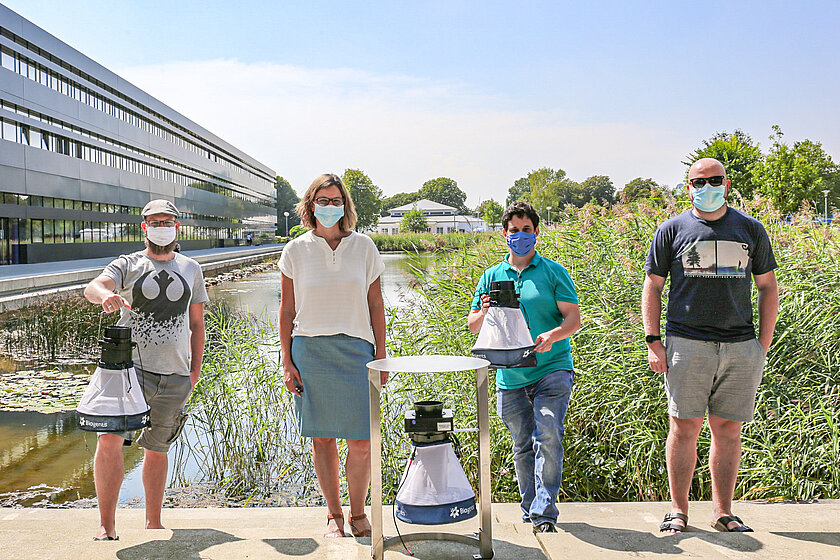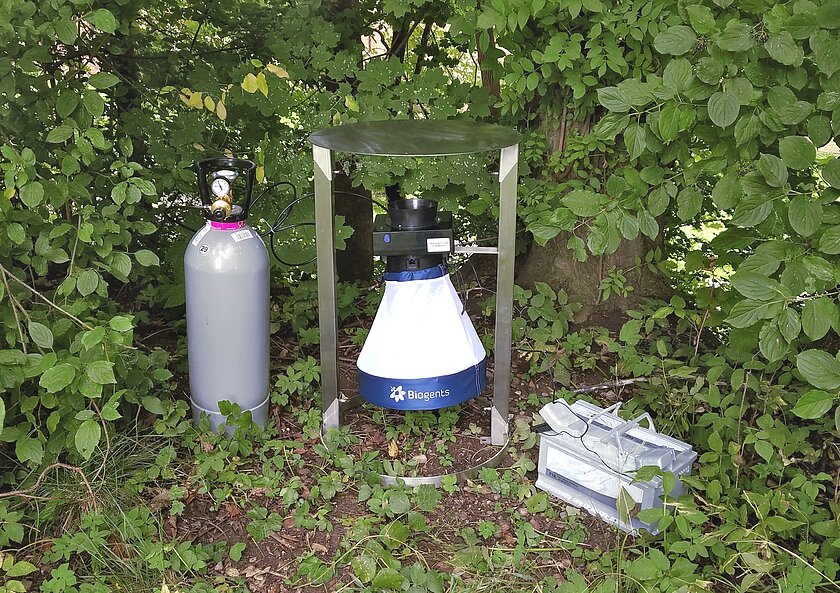Remote Sensing and On-Site Characterization of Wetlands as Potential Habitats for Malaria Vectors
Insect-borne diseases are an ongoing threat to public health. Among other common known diseases, malaria is still a worldwide health problem and also of relevance in colder regions. The spread of this disease is currently supported by the increase of wetland areas, environmental change, warming, a decrease of pesticide use and an overall mosquito import via travel. That’s why HNU’s DigiHealth Institute and Biogents combine natural and health science methods to identify potential future mosquito risk areas in the new research project "Swammp" (Swabian Mosquito Monitoring Project).

Dr. Silke Göttler (2nd from left) of the Biogents AG (Regensburg) and members of HNU’s DigiHealth Institute (Michael Örtl, Swammp coordinator Dr. Martin Schmieder, and Felix Holl; from left to right) with a "BG-Trap Station" including an electronic mosquito counting module (in front) and two mobile BG-Pro traps at the HNU lake. The trap station, which can be operated with carbon dioxide from a gas cylinder and a car battery, has already been used several times and at different locations in the region during the test phase of the Swammp project. The image was taken in August 2020.
By using freely available satellite image data and software as well as our mosquito trap system, the identification and characterization of potential breeding grounds are the researchers‘ goals. The combination of a permanent monitoring via satellite data, field work on the ground and the use of digitized mosquito traps generates a quasi-panoptical view of mosquitoes and their habitat.
The initial pilot study at Lake Schmiechen (Swabian Alb, southern Germany) has already proven this approach to be a powerful opportunity to remotely monitor relatively small bodies and narrow networks of open shallow water that may provide habitats for mosquitoes. It offered ideal research conditions because it contains water-accumulating former floodplain sediments, which ensure that it is repeatedly flooded and then dries up again to a large extent and becomes silted up. Lake Schmiechen can be considered an analog site for other lake and wetland areas potentially populated by malaria vector mosquitoes.
Due to the necessity of low financial and material resources, this approach can be adapted to regions worldwide in the future. The initial plan is to transfer the project into a networked, Germany-wide monitoring of invasive and disease-transmitting mosquitoes. In the future the improvement of hazard maps worldwide can help to better control diseases that affect millions of people.
Moreover it can complement public health programs and humanitarian efforts to not only fight vector-borne diseases such as malaria but also monitor water quality, flood disasters, irrigation, agriculture and much more.

In action: the digital mosquito trap
Initial results of the Swammp project’s test phase were presented at the virtual IEEE Global Humanitarian Technology Conference (GHTC Seattle, USA) October 30, 2020.
After determining the genus and species of the mosquitoes caught, the following were found among them: Anopheles maculipennis, Anopheles plumbeus, Culiseta moristans, Culex pipiens and Aedes japonicus. The genus Anopheles are common known malaria mosquitoes. During the test phase from end of August to mid of September 2020, almost twice as much Anopheles (76) mosquitoes were caught than Culex (39). In addition to recording their main periods of activity, mosquito monitoring also provided another initial finding: the invasive species Anopheles did not, as assumed, occur mainly in standing water, but often occurred precisely in the combination of periodically drying lakes and forest areas, not only in rural areas but also in cities.
The project will be carried out using a network of digital mosquito traps in parts of Baden Württemberg and Bavaria (southern Germany) from this mosquito season onwards planned until 2022.
For further information, have a look at:
- HNU Short Article
- HNU Interview with PD Dr. Elmar Buchner & Dr. Martin Schmieder
- Future Code Bayern Short Article
- Latest Research Paper in this Context (peer-reviewed)






